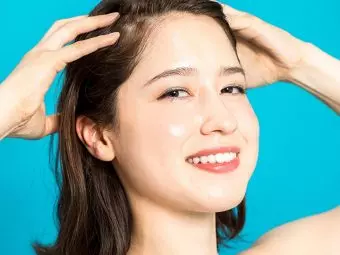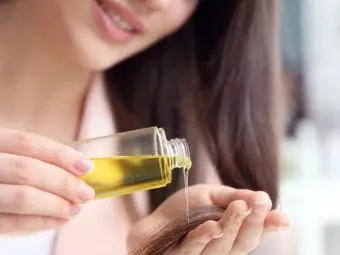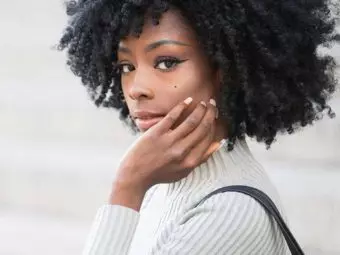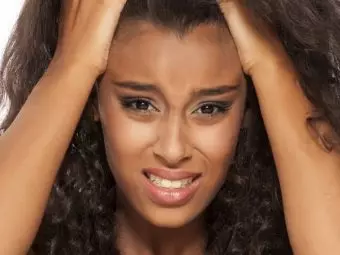Some people struggle with the unusual urge to pull out their own hair. This is an impulse control disorder called trichotillomania, also known as the hair-pulling disorder. Here, we explain how to stimulate hair regrowth as you deal with trichotillomania.
Pulling out your hair can damage the scalp and hair shafts. Patients dealing with this disorder incur hair loss and hair regrowth issues. It affects their confidence and may even require counseling and therapy. But rest assured, as recovery from this disorder is possible in most cases. Keep reading to know what causes trichotillomania and how you can manage it effectively.
In This Article
What Is Trichotillomania?
Trichotillomania is an impulse control disorder that leads to patients pulling out their hair (1). People with this disorder have an intense urge to pull their hair out. They experience a sense of built-up tension that only pulling hair out can relieve. Over a period, trichotillomania damages the hair follicles.
Patients develop bald patches, which often cause low self-esteem and a feeling of shame. Trichotillomania is also associated with depression and anxiety (2). Hair regrowth can elevate the self-esteem of such individuals and help them feel more confident.
What factors contribute to trichotillomania? Let us understand the same in the next section.
What Factors Contribute To Trichotillomania?
While it is not clear as to what exactly causes trichotillomania, a lot of factors may contribute to its development. These include:
- Anxiety or trauma, shock, depression
- Childhood trauma or instance of conflict in the family, abuse, death, etc.
- Hormonal changes during the age of puberty
- Self-harm tendencies due to underlying distress
But how do you know for sure if a person has trichotillomania?
How To Diagnose Trichotillomania
Patients showing a few or all of these signs can be diagnosed with trichotillomania (3):
- Recurrent hair pulling that causes severe haphazard bald patches.
- Repeated attempts to stop hair pulling.
- Impacted social and occupational functioning due to hair pulling.
- Hair loss not attributed to any other medical or dermatological condition.
- Unexplained hair pulling that cannot be attributed to other mental disorders.
The onset of trichotillomania is usually seen in adolescents and young adults. As a lot of these patients often feel shame or embarrassment, they do not talk about the disorder. Trichotillomania in such patients can be diagnosed by keeping a few key symptoms in mind.
- Bald spots on the scalp.
- Broken hair of different lengths and uneven hair volume on the head.
- Uneven or scant eyelashes.
- Chewing of hair (in extreme cases).
- Unwillingness to socialize.
- Preference to stay indoors.
People with trichotillomania often hide bald spots and stay in denial about the underlying mental health issues that lead to hair pulling. There are many such complications associated with trichotillomania. We have covered a few below.
Complications Associated With Trichotillomania
- Delayed Diagnosis
In a lot of cases, patients are often secretive about their habit of hair-pulling. They may also resort to lying due to shame. This can lead to misdiagnosis and wrong treatments being prescribed. The right treatment could get delayed and cause long term skin and hair damage. Only a trained hair specialist can recognize trichotillomania associated with hair pulling with signs like stubby hair, and irregular and geometric bald spots.
- Emotional Distress
Hair loss associated with trichotillomania often results in more emotional distress, with people developing body issues and shame.
- Hair And Skin Damage
Pulling of hair can result in permanent skin damage over the years. It can also damage the hair follicles and impair the normal rate of hair growth, especially in cases where people pull out hair from private body parts.
- Poor Self-Esteem
Teenagers with trichotillomania can have a hard time developing stronger self-esteem and self-confidence. Even slight bald patches can hurt one’s self-confidence at that age. This may even affect their notion of self-worth.
- Social Dysfunctioning
People with trichotillomania often become too conscious about their appearance. A lot of them resort to wearing wigs, bandanas, or scarves. This affects their social and work life. Some people also suffer from intimacy issues due to the fear of their partners discovering their habits.
Does The Pulled Out Hair Grow Back?
For most patients, recovering from the mental stress of trichotillomania can be much smoother if hair regrowth occurs and the bald patches subside. Patients must always visit a licensed practitioner who understands the condition better.
For the majority of people with trichotillomania, hair regrowth occurs naturally. It may take a little longer, but hair does grow back if the hair follicles are not completely damaged. However, those with broken hair shafts have a higher chance of permanent hair loss. The time taken for hair to grow back may also be higher than normal, especially if they have been pulling hair out for years. In some severe cases, the hair follicles may be too damaged to allow any regrowth.
There are several treatments available for trichotillomania. Here, we discuss some of them.
How Do You Treat Trichotillomania?
Trichotillomania is an impulse control disorder. Hence, those with the condition are often prescribed behavioral treatments.
- Habit Reversal Therapy (HRT)
Here, the undesirable habit is replaced with something that is not harmful – like journaling or keeping a squeeze ball and working on the triggers.
- Acceptance And Commitment Therapy (ACT)
Here, the patient is taught how to accept the urges and normally live with them without having to pull their hair out.
- Cognitive Behavioral Therapy (CBT)
Here, patients learn to accept any form of distorted beliefs pertaining to hair pulling. This therapy may help reduce the frequency of hair pulling in patients.
- Pharmacotherapy
A doctor may sometimes prescribe pharmacotherapy – which includes a dose of 1200 mg of N-acetyl cysteine to be given twice a day (4). In a study, this treatment had shown remarkable results in 4 to 6 months (5). Doctors may also prescribe medications like serotonin reuptake inhibitors (SRI), fluoxetine (Prozac), sertraline (Zoloft), fluvoxamine (Luvox), clomipramine (Anafranil), paroxetine (Paxil), valproate (Depakote), and lithium carbonate (Lithobid, Eskalith), depending on the case.
Subscribe
There are several other useful treatments that people with trichotillomania can follow. Check them out.
Other Treatments For Trichotillomania
The following treatments help improve the physical and mental well-being of patients.
- Seek help. Trichotillomania is triggered by underlying issues and trauma that can be treated only if you speak up and share. Don’t be afraid to accept that you have this condition. Seek help in time to prevent any permanent damage.
- Wear a wig or bandana, as hair pulling can be difficult under the headgear.
- Hair regrowth treatment can be a blessing. Various treatments for hair regrowth can help treat hair loss- and baldness-related stress in patients. Laser therapy also can help treat hair loss.
- One may also explore trichological therapy that involves the stimulation of blood supply and vasodilation of the blood vessels at the base of the hair follicles.
- Trichotillomania is often associated with depression, abuse, trauma, or anxiety. Treating these underlying causes can also help – and one way to do that is undergoing therapy for these mental health issues.
- Other simple methods include taking a relaxing bath, getting a shorter haircut, putting plaster or acrylic nails that make pulling hair impossible, and practicing deep breathing.
Trichotillomania, the hair-pulling disorder, can damage your scalp and hair follicles, leading to hair loss and bald patches. However, hair re-growth following trichotillomania occurs naturally in most people. But, it happens rather slowly. If the hair shafts are completely damaged following years of hair pulling, the chances of re-growth get slimmer. So, early diagnosis is essential. Besides behavioral treatments, your doctor may prescribe pharmacotherapy, which can show excellent results in 4-6 months. This disorder is mostly associated with depression, trauma, and anxiety. Focusing on treating these conditions may help reduce the urge to pull out your hair and aid in recovery.
Frequently Asked Questions
How long does hair take to regrow for someone with trichotillomania?
The duration varies among individuals. But in most cases, the hair does regrow once the individual stops pulling their hair.
What is the best trichotillomania treatment for hair regrowth?
While the treatment for trichotillomania is different for every individual, therapy for treating the underlying mental health condition is a better option.
Does trichotillomania lead to regrowth of gray hair?
Yes, in some cases, trichotillomania may lead to regrowth of gray hair.
Can trichotillomania be life-threatening?
If trichotillomania is accompanied by trichophagia (where patients eat the hair they have pulled out), one may experience intestinal obstruction that can be life-threatening.
How can an individual with trichotillomania help themselves?
The best way an individual with trichotillomania can help themselves is by reporting the condition to a doctor and seeking treatment from therapists or other professionals.
Key Takeaways
- Trichotillomania or the unusual impulsive urge to pull hair might lead to hair thinning, bald spots, and scalp damage.
- Hair regrowth options not only helps maintain your scalp health and hair volume but also helps regain your confidence.
- Addressing the root cause of anxiety and opting for hair regrowth therapy options can help get your hair back in its usual length, strength, and texture.
References:
Articles on StyleCraze are backed by verified information from peer-reviewed and academic research papers, reputed organizations, research institutions, and medical associations to ensure accuracy and relevance. Read our editorial policy to learn more.
Trichotillomania and Its Treatment: A Review and Recommendations
https://www.ncbi.nlm.nih.gov/pmc/articles/PMC3190970/
Trichotillomania and Its Clinical Relationship to Depression and Anxiety
https://pubmed.ncbi.nlm.nih.gov/28429625/
Diagnosis Evaluation and Management of Trichotillomania
https://www.ncbi.nlm.nih.gov/pmc/articles/PMC4143797/
Trichotillomania
https://ajp.psychiatryonline.org/doi/10.1176/appi.ajp.2016.15111432
N-Acetylcysteine in the Treatment of Trichotillomania: Remarkable Results in Two Patients
https://onlinelibrary.wiley.com/doi/abs/10.1111/jdv.13690
Related
The following two tabs change content below.
- Author
- Reviewer

Arshiya Syeda
Arshiya Syeda is an editor at StyleCraze. Prior to that, she was a content writer and combined her writing and… more
Richard Spencer
(MIT)Richard Spencer is a qualified trichologist and registered member of the Institute of Trichologists (M.I.T.). He began his own practice… more



 How To Use Jamaican Black Castor Oil For Hair Growth
How To Use Jamaican Black Castor Oil For Hair Growth How To Exfoliate Your Scalp At Home To Clear Excess Oil
How To Exfoliate Your Scalp At Home To Clear Excess Oil How To Apply Oil On Hair: A Step-By-Step Guide
How To Apply Oil On Hair: A Step-By-Step Guide How To Use Coconut Oil For Dry Scalp And Dandruff
How To Use Coconut Oil For Dry Scalp And Dandruff Easy Way To Get The Perfect Twist Out On 4C Natural Hair
Easy Way To Get The Perfect Twist Out On 4C Natural Hair Eyebrow Hair Loss: Causes, Prevention Tips, & DIY Methods
Eyebrow Hair Loss: Causes, Prevention Tips, & DIY Methods Types Of Hair Loss, Causes, Treatments, & Prevention Options
Types Of Hair Loss, Causes, Treatments, & Prevention Options Itchy Scalp And Hair Loss: How To Treat And How To Prevent It
Itchy Scalp And Hair Loss: How To Treat And How To Prevent It What Is Hair Texturizing? How To Take Care Of Texturized Hair?
What Is Hair Texturizing? How To Take Care Of Texturized Hair?